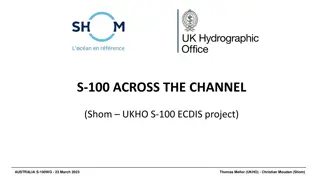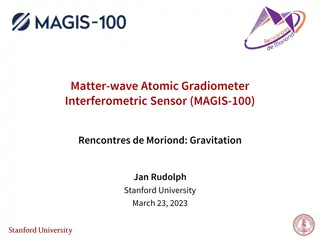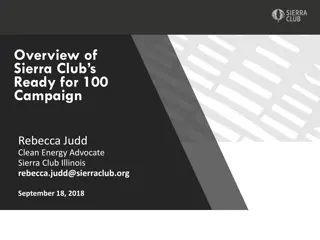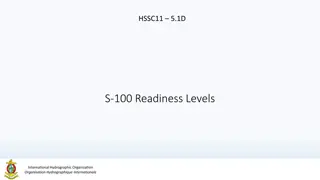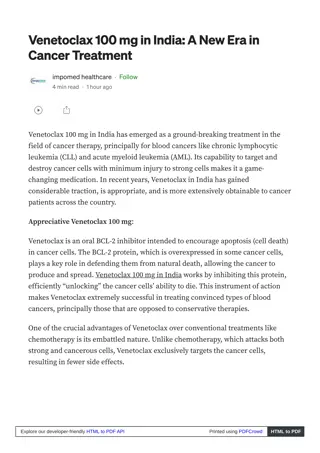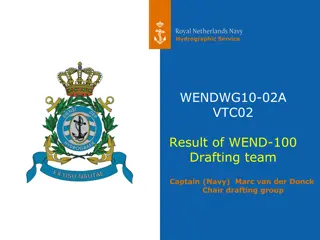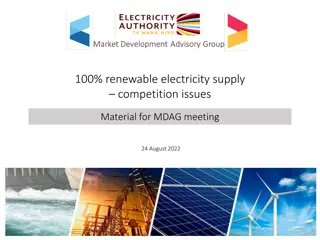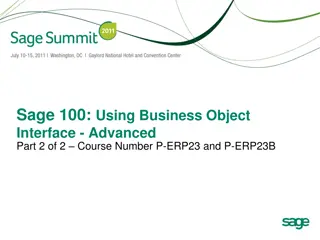AION 100 – a strawman
The AION100 project presents a need for a 100m interferometer with a strawman proposal outlined by Ian Wilmut on behalf of Pawel Majewski and Tristan Valenzuela-Salazar. Starting assumptions include building in small modules, crane access, and progressive testing during assembly. Detailed shaft cross-section and module designs are discussed for efficient operation.
Download Presentation

Please find below an Image/Link to download the presentation.
The content on the website is provided AS IS for your information and personal use only. It may not be sold, licensed, or shared on other websites without obtaining consent from the author.If you encounter any issues during the download, it is possible that the publisher has removed the file from their server.
You are allowed to download the files provided on this website for personal or commercial use, subject to the condition that they are used lawfully. All files are the property of their respective owners.
The content on the website is provided AS IS for your information and personal use only. It may not be sold, licensed, or shared on other websites without obtaining consent from the author.
E N D
Presentation Transcript
AION 100 a strawman Ian Wilmut on behalf of Pawel Majewski and Tristan Valenzuela-Salazar
Aims In our view the AION100 project needs a strawman for a 100m interferometer These slides are an attempt to construct a strawman that we propose to use as our starting point going forward. This is not an attempt to design AION100, instead it is a single set of options that COULD work None of this is fixed, it can all be changed, all elements remain open for discussion
Starting assumptions Assume a shaft not a tower Keep the shaft small presently 2.4m diameter 2m shaft was attempted, but proved impractical (cold not extract hardware) Plan to build in many small modules Presently 5m modules could sensibly be up to 10m sections Assume minimum of 3 atom sources, could be many more Up to one per module would be consistent with approach this would be 20! Assume crane access Keep option of assembly hall at top or bottom of shaft Build up from the bottom (down from top is difficult for crane) Assume progressive testing as the system is assembled Do not exclude fully commissioning (install, bake, vacuum) each module in turn
Shaft cross section Working with assumed constraints More space obviously makes things easier Shaft 2.4m diameter shaft Round Perfectly vertical any incline or bend will require a larger shaft Platforms 2 independent access platforms in shaft Each platform large enough for 2 people Platforms to be able to carry atom sources, ion pumps up and down etc. NOT free hanging, needs rails (avoids swinging cage colliding with detector
Use of shaft cross section Access platform #1 drive ladder Access platform #1 Crane access - enables limited crane use with 2 platforms Interferometer services (full length of shaft minimal connectors) Beam pipe Atom source, in cage and removable 90th percentile male figure Ion pump Module brackets core bolts to shaft wall Access platform #2 2x people of 1x person+ atom source or similar
Two modules in shaft A single module Interface to attach to shaft brackets Welded steel (or SS) frame Atom sources can t be lifted into position with crane no access* Segmented Shielding (2 layers) 4x supports along 5m length Structure has closure panels to help keep things clean Atom source in removable cage 1 x module 5m Side platform for atom source Removable Ion pump * If we limit to 3 sources then they could be cranes in as just one will sit in the shaft and the others can be orthogonal
Why build in 5m modules? The modules must be able to be installed in the shaft, this defines the hall height. A 5m module requires a 7m hall to fit in the crane etc. A 10m module would require a 12m hall! Larger modules will reduce number of available sites Building in situ will be very hard Anything dropped 100m will do very significant damage Manipulation of all the parts in the shaft will be difficult Lots of crane work will be needed for long parts much risk 5m modules assumed to be built on their side Modules can be tested (and maybe initial-baked) before installation Large number of fasteners for shielding can be installed with good access and no risk from dropping
Beam pipe detail X and Y adjustments of beam pipe position (position and straighten) Inner shield (green) Top of pipe will have fixed flange Bottom of pipe to have bellows and rotating flange Shield made from 8 phi segments 1->2m long Field wires in tubes to enable replacement in event of failure Field wire tubes Vertical support plate Module frame Outer shield (orange) Closure panels Beam pipe flange Shield support (brown)
Interface between modules The module structures will have a gap between them All loads and constraints will be defined and carried by the brackets on the walls of the shaft Closure sections of the shield will need to be installed in situ around the vacuum flange interface Note this interface will need to be able to move in Z for CTE effects This make up section needs to minimise dropping parts Bellows will enable the beam pipe to connect and will be pre-compressed to enable the modules to be positioned before the sealing faces together. Work needed on temporary caps
CTE We need to understand the thermal profile of environment A shaft will likely be very thermally stable Unless there is non-constant work happening at the bottom that generates heat, or the tunnel complex has multiple entries. A tower will vary seasonally, especially if there is a large chamber at the top or bottom 100m of metal will: Expand 1.2mm/K over its length if made from steel/iron Expand 2.4mm/K over its length if made from Aluminium Concrete has similar CTE to steel. This may somewhat mitigate tower thermal gradient. CTE will need to be provided for in the design In the case of the pipe the bellows probably provide adequate conformance In the case of the shield, compliance will be needed The structure will not be continuous so the CTE will be less significant to structure
Atom Source in a box Atom Sources are designed to be completely removable This is done by installing them into a frame Present footprint is 1m x 600mm Frame should be able to be closed and dust tight (IP51?) Source will be able to be lifted by crane or lifted on the access platform The assumption is that all building, commissioning, testing and repair of sources will happen not in situ
Crane access Looking at the plan view it is evident that atom sources and Ion pumps can t be craned directly up the shaft as higher sources obstruct the shaft If we limit ourselves to 3 sources (top, middle, bottom) we could orientate them so they can be craned out (see doodle) Is this a worthwhile limitation? This would simplify the design (no need to carry sources on access platforms), but would prevent later additions Mid Top Btm
Issues (list incomplete) Dropping parts and tools Keeping pipe clean as it is opened to attach next section we don t want 20 gate values Position adjustments between module and shaft wall Keeping dust out of everything How to bake with self heating Closing the shield at module breaks Connecting field wires and maintaining tension Penetrating shield with beam pipe supports without reducing shielding Bellows forces (1800N vertically for a 6 pipe) Pump locations and access Service methodology and routing
Conclusion To complete a full costing and making of a project plan we need an agreed strawman to serve as a baseline The AION community are asked if this can form such a model? If it needs modification now is the time to do so If we can agree this model then we can start a detailed costing For now it is proposed that the AION 100 project costs everything independently of AION 10 and then we remove duplication as we start to see what can be shared. Duplicate activities are assume to end up in AION 10
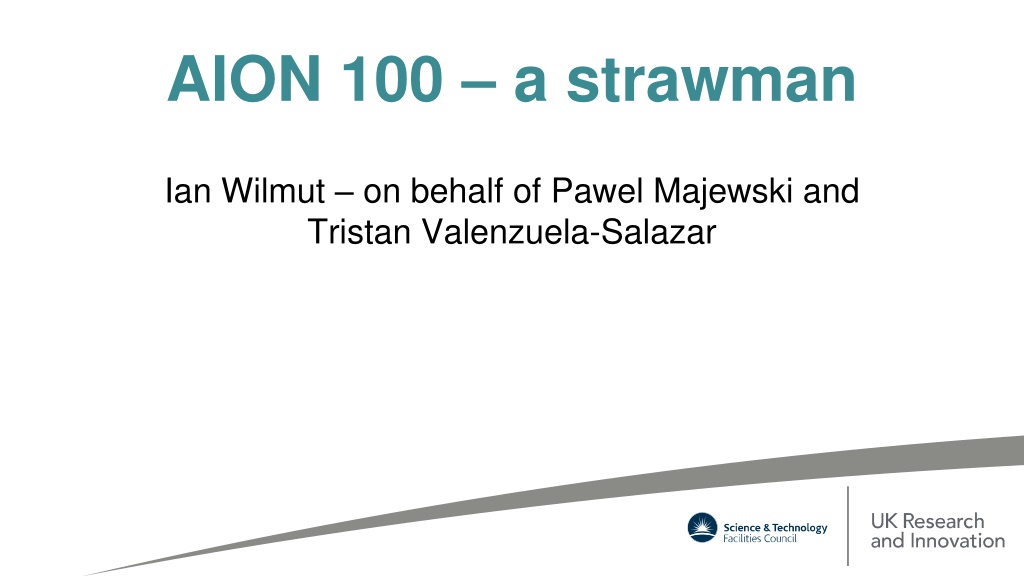




![[PDF⚡READ❤ONLINE] Tutankhamun's Trumpet: Ancient Egypt in 100 Objects from the](/thumb/20549/pdf-read-online-tutankhamun-s-trumpet-ancient-egypt-in-100-objects-from-the.jpg)
